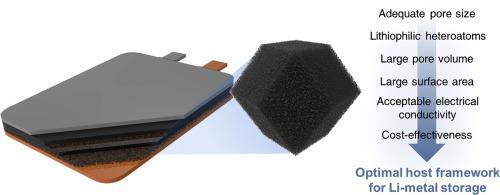Energy Storage Materials ( IF 18.9 ) Pub Date : 2020-08-07 , DOI: 10.1016/j.ensm.2020.07.015 Yuhwan Hyeon , Jaewoo Lee , Hamzeh Qutaish , Sang A Han , Seung Hyun Choi , Sung Won Moon , Min-Sik Park , Dongmok Whang , Jung Ho Kim

|
Due to the increasing demands for energy storage devices with higher energy density, lithium (Li) metal is considered to be the ultimate choice as an anode material because it has a high theoretical capacity (3860 mAh g−1) and the lowest reduction potential (−3.04 V versus standard hydrogen electrode) among all the alkali metals. Despite these advantages, repeated Li plating/stripping during cell operation leads to dendritic Li and the formation of irreversible Li (dead Li), leading to internal short-circuits and capacity fading. These fundamental problems cause safety issues and cell failure, so they must be resolved to commercialize Li-metal anode. Many in-depth studies are ongoing to solve these drawbacks through a variety of approaches, such as the formation of artificial solid-electrolyte interphase (SEI), inserting an interfacial layer between the electrolyte and electrode, demonstrating three-dimensional structured electrodes, and using stable host structures to store Li-metal. In this Review, we focus on using host materials to store Li-metal among various strategies, which may be regarded as an alternative method but is very feasible. Also, we propose porous carbon materials derived from zeolitic imidazolate frameworks (ZIFs) as the host materials due to their suitable properties for Li-metal storage. To advance progress towards practical application, the Li-metal storage capacity of porous materials is mathematically inferred, and further strategies are discussed for improving the storage capacity in this regard. Finally, we presented a perspective that paves the way for applying host materials to anodes of practical Li-metal battery.
中文翻译:

锂金属在沸石咪唑酸盐骨架中的纳米结构存储
由于对具有更高能量密度的储能设备的需求不断增加,锂(Li)金属被认为是阳极材料的最终选择,因为它具有很高的理论容量(3860 mAh g -1)和所有碱金属中最低的还原电位(相对于标准氢电极为-3.04 V)。尽管具有这些优点,但在电池运行过程中重复进行Li镀/剥离会导致枝状Li形成并形成不可逆Li(死Li),从而导致内部短路和容量衰减。这些基本问题会导致安全问题和电池故障,因此必须解决这些问题才能使锂金属阳极商业化。正在进行许多深入的研究,以通过各种方法来解决这些缺点,例如,形成人工固体-电解质界面(SEI),在电解质和电极之间插入界面层,演示三维结构化电极以及使用稳定的主体结构来存储锂金属。在这篇评论中,我们专注于使用主体材料在各种策略中存储锂金属,这可以被视为替代方法,但非常可行。同样,由于它们适合锂金属存储,我们提出了由沸石咪唑酸盐骨架(ZIF)衍生的多孔碳材料作为主体材料。为了促进实际应用的进展,从数学上推断了多孔材料的锂金属存储容量,并讨论了在这方面提高存储容量的其他策略。最后,我们提出了一种观点,为将主体材料应用于实际锂金属电池的阳极铺平了道路。由于它们适合锂金属存储,我们提出了由沸石咪唑酸盐骨架(ZIF)衍生的多孔碳材料作为主体材料。为了促进实际应用的进展,从数学上推断了多孔材料的锂金属存储容量,并讨论了在这方面提高存储容量的其他策略。最后,我们提出了一种观点,为将主体材料应用于实际锂金属电池的阳极铺平了道路。我们提出了由沸石咪唑酸盐骨架(ZIFs)衍生的多孔碳材料作为主体材料,因为它们适合用于锂金属存储。为了促进实际应用的进展,从数学上推断了多孔材料的锂金属存储容量,并讨论了在这方面提高存储容量的其他策略。最后,我们提出了一种观点,为将主体材料应用于实际锂金属电池的阳极铺平了道路。











































 京公网安备 11010802027423号
京公网安备 11010802027423号